10 Iconic Foods That Originated In The State Of Georgia
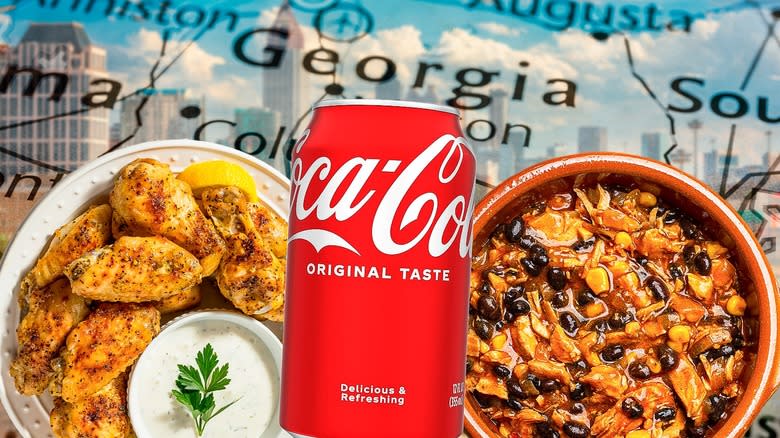
What foods come to mind when you think of the state of Georgia? It is the Peach State, after all, so peach cobbler, pie, or ice cream are probably high on the list. Perhaps instead you envision Southern classics like pimento cheese, boiled peanuts, or shrimp and grits. All of these dishes are popular in Georgia, and you can get excellent versions of them there, but none of them actually originated in Georgia.
That's not to say Georgia never came up with important culinary innovations. It's a state with fascinating food history, and some of America's favorite fast-food restaurants and soft-drink companies got started there. The state has also put its own spin on staple American foods like burgers, wings, and fries. Georgia's native dishes follow the ethos of Southern cuisine as a whole: They tend to be rich, full of flavor, and not skimpy on calories. From Brunswick stew to Vidalia onions, here are 10 iconic foods and drinks that originated in Georgia.
Read more: Styles Of Regional BBQ In The US
Lemon Pepper Wings
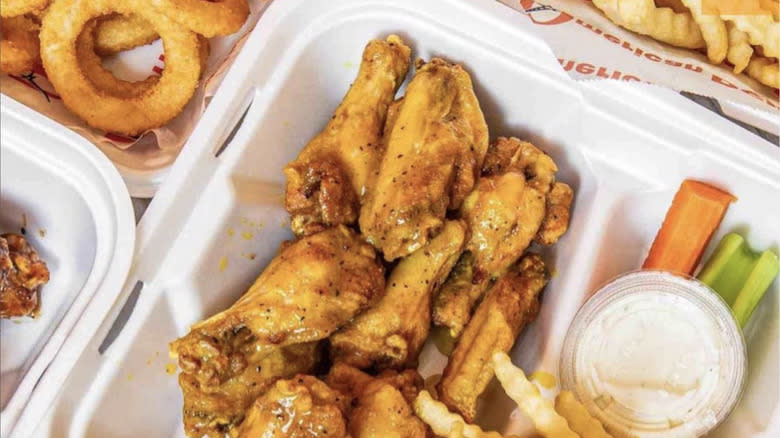
We all know that Buffalo wings come from Buffalo, New York, but the classic blend of Frank's RedHot and butter isn't the only way to dress up deep-fried chicken. We can thank Atlanta, Georgia for popularizing a more recent twist on the formula: lemon pepper wings.
While the specific origins of lemon pepper wings are lost to time, a widespread theory is that they arose as a mild alternative to Buffalo wings for children and other people who didn't enjoy hot food. Lemon pepper seasoning mix typically contains black pepper, lemon oil or extract, and citric acid, combining the zest of citrus with the bite of pepper. It makes wings flavorful without being spicy. Lemon pepper may have started as an at-home hack for livening up mild wings, but it has become a fixture on Atlanta's wing joint (and strip club) menus over the years.
The most common version of lemon pepper wings are simply fried and coated in dry seasoning. A locally created variation, called lemon pepper wet, got a major boost in prominence after this style of wings was featured in Season 1 of "Atlanta" on FX in 2016. Pioneered by Atlanta's own American Deli chain, this style mixes the dry seasoning with melted butter (or, at some restaurants, Buffalo wing sauce). This way, you get the best of both worlds: zesty lemon pepper flavor with a saucy finish.
Chick-Fil-A Chicken Sandwich
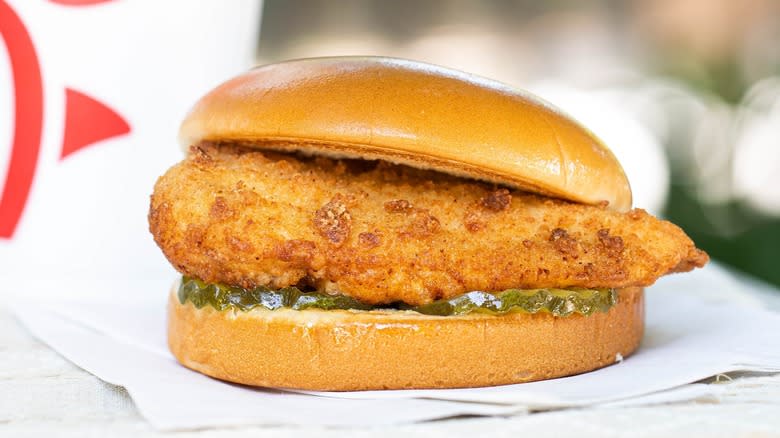
Chick-fil-A's founder, S. Truett Cathy, came up with the recipe for the chain's signature dish himself — he went through hundreds of prototypes before settling on the final formula in 1964. The first Chick-fil-A restaurant followed soon after that, launching in 1967. Its original location was in Atlanta, in the Greenbriar Shopping Center food court.
It's been said that Chick-fil-A invented the boneless fried chicken sandwich, but that assertion does not appear to be true. Instead, the dish may have been a creation of African-American cooks — there's a reference to a fried chicken sandwich in a Black newspaper from Topeka, Kansas from 1936, three decades before Chick-fil-A was founded.
While Cathy didn't invent the fried chicken sandwich, there's no doubt that Chick-fil-A helped to turn the dish into a sensation. The company's iconic combo of seasoned fried chicken breast, buttered bun, and pickle slices is famously delicious. The chain is quite secretive about its recipe, but we do know that the chicken is hand-breaded and pressure-cooked in peanut oil. Copycat Chick-fil-A sandwich recipes use seasonings like paprika, garlic powder, white pepper, and even a touch of powdered sugar to try to recreate the chain's fast-food magic.
Vidalia Onions
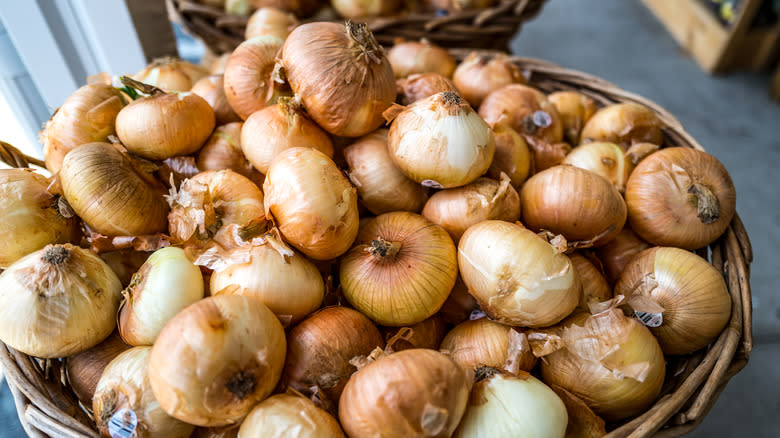
Vidalia onions are so associated with Georgia that they have been named as the official state vegetable. Their history stretches back to 1931, when a farmer named Moses Coleman in Toombs County, Georgia (where the city of Vidalia is located) began growing onions that were noticeably sweeter than normal. The area's reputation for producing sweet onions grew over time, and in 1986, the onions' provenance was protected by a Georgia state law. True Vidalia onions can only be grown in 20 counties in Georgia, and the name "Vidalia onion" has been federally regulated since 1989.
Vidalias are sweeter and less hot than other onion varieties because they're high in sugar and low in sulfur. The sugar is obviously what makes them sweet — at 12% sugar content, they have more than twice as much as a standard onion. Sulfur is the compound responsible for giving onions pungency. The soil around Vidalia contains low amounts of sulfur, which explains why there's so little of it in these onions. Vidalia onions are so sugary and mild you can even use them raw as a sandwich filling — sweet onion sandwiches are a traditional party treat in Georgia.
Coca-Cola

Coca-Cola might be Georgia's most widely loved culinary export. The multinational beverage titan got its start in 1886 when an Atlanta pharmacist, Dr. John Stith Pemberton, concocted a drink syrup that he sold as a soda fountain beverage. As befitting its medical origins, Coca-Cola was originally marketed as a health-boosting tonic and headache reliever, though its pleasant taste and refreshing qualities were part of its appeal from the very beginning (that, and the fact that the original recipe contained cocaine and large amounts of caffeine). While Pemberton had created a classic beverage, he wasn't a great businessman. Asa G. Candler took over the company after Pemberton's 1888 death and helped it grow.
Coca-Cola is famously tight-lipped about its secret recipe, but we know the cocaine was removed early in the 20th century. There is a widely available recipe allegedly from John Pemberton that could be the original formula for Coca-Cola, though the company still keeps the actual recipe locked in a vault. In addition to coca leaf extract and a whopping dose of caffeine (five times as much as modern Coke), the recipe includes sugar, vanilla, lime juice, and oils of nutmeg, coriander, and cinnamon.
Brunswick Stew
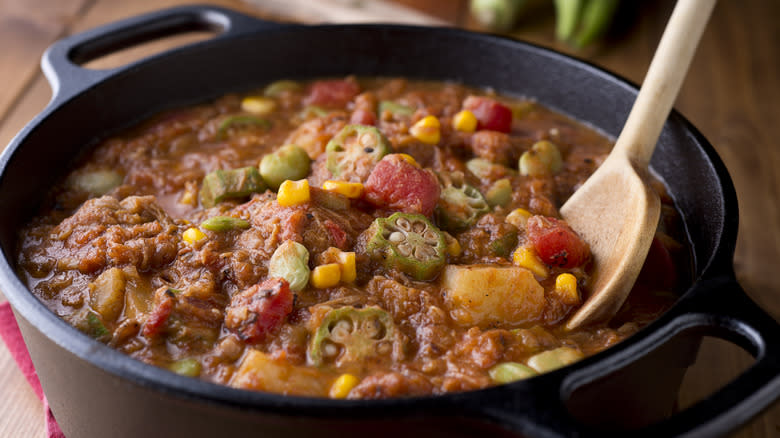
This one is contentious, because two Southern states claim Brunswick stew as their own: Georgia and Virginia. Peach State residents say the stew was invented in Georgia's coastal city of Brunswick, or on one of the islands in the area. Proposed dates for the supposed invention range from 1898 in Georgia, to 1828 in Brunswick County, Virginia.
Actual documentation of the history of Brunswick stew in Georgia is scant. Virginia has a stronger case if you go by the written record, with a reference to Brunswick stew appearing in an Alexandria newspaper as early as 1849. In the mid-1800s, the recipe featured squirrel meat, mixed vegetables, and some bacon for seasoning.
We may never know who invented this dish for sure, but either way, it's a popular part of Georgia's modern-day dining scene, especially at barbecue restaurants. These days, it's often made with leftover barbecued meat and okra, but its history of containing whatever vegetables you have on hand has been preserved — corn and lima beans are popular options. The Brunswick stew recipe may even be spiked with barbecue sauce.
Nu-Way Weiners
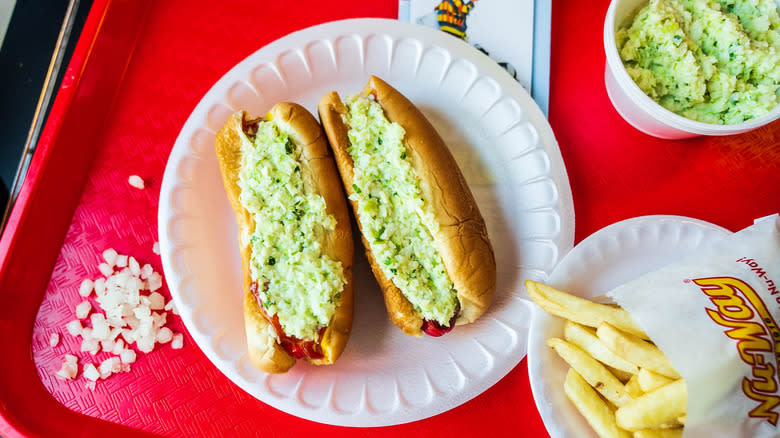
That's not a typo. The most famous hot dog purveyor of Macon, Georgia sells "weiners" — not wieners. Nu-Way has been spelling its main menu item that way since 1937, when the restaurant hung a neon sign out front with the now-iconic misspelling. The business has been around even longer; it all started with a single hot dog stand in 1916. Today, there are eight Nu-Way locations, all in the state of Georgia.
Nu-Way is famous for its distinctive bright red hot dogs topped with chili, but arguably its most celebrated menu item is a more recent creation (at least relatively recent for a business that's over a century old). Its slaw dog has been honored as one of the best frankfurters in the nation, and it didn't hit the menu until the 1980s.
What is a slaw dog? It's a Southern treat consisting of a hot dog topped with coleslaw. Nu-Way's slaw recipe is a simple blend of finely chopped cabbage with coleslaw dressing, but no carrots. The combination of cooling, creamy slaw and a "weiner" has earned legions of fans over the years, from Georgia politicians to New York Times reporters to Oprah Winfrey.
Zaxby's Chicken Fingers
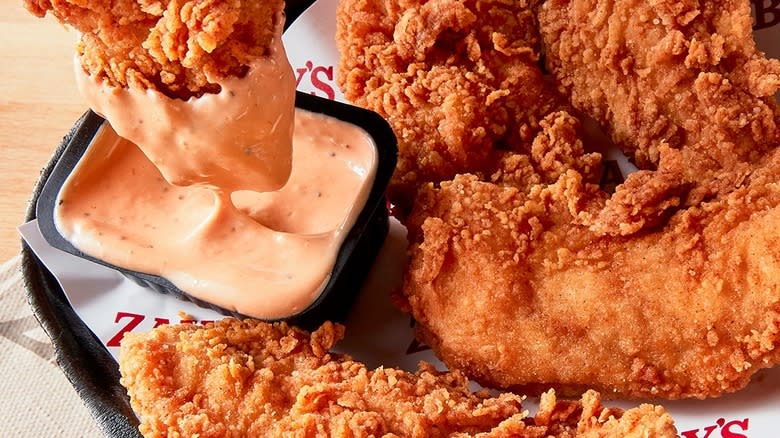
It's clear that Georgia has done more for the art of chicken cookery than most other states. In addition to lemon pepper wings and the Chick-fil-A chicken sandwich, Zaxby's chicken fingers were also born in the Peach State. Zach McLeroy and Tony Townley founded the chain in Statesboro, Georgia in 1990 before franchising to expand the business four years later. There are now over 900 locations, many of which are concentrated in the Southeast.
Like most fast-food places, Zaxby's isn't going to tell you what exactly it puts in its coveted chicken fingers — and the chain is equally protective of its Zax Sauce recipe, since chicken strips are nothing without a dipping sauce. Zaxby's has many condiment options, but its original sauce is hard to beat. Some home cooks believe that a mix of mayo, ketchup, and Worcestershire sauce will get you pretty close. Garlic powder, hot sauce, vinegar, or black pepper may also come into play. The creamy, tangy, savory, slightly sweet sauce is a perfect partner for freshly fried chicken fingers.
Waffle House Hash Browns
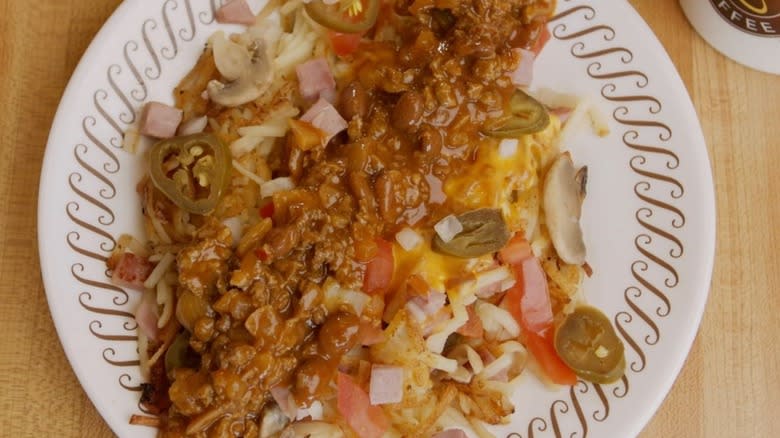
Hash browns weren't invented in Georgia, but they just might have been perfected there. We could have picked any number of dishes to represent Waffle House, the breakfast mega-chain founded in Avondale Estates, Georgia. Waffles would have been a natural choice, of course. The All-Star Special breakfast plate — featuring eggs, meat, toast, and a waffle — is a good representation of everything that Waffle House does well. However, hash browns are probably Waffle House's most distinctive menu offering.
Any Waffle House fan knows that you don't have to stick to plain potatoes when you're ordering the chain's hash browns. You can get them with a wide variety of toppings, each with its own special code word. First, you can order them "scattered," which means spread over the griddle for extra crispiness. "Smothered" means mixed with cooked onions. "Covered" is topped with cheese. "Chunked" adds ham.
These are just a few of the ways you can mix and match hash brown styles to your heart's content at Waffle House — but if you want to go wild, order them "all the way," which means adding onions, cheese, ham, jalapeños, tomatoes, mushrooms, chili, and gravy. Only at Waffle House can you get such a filling meal just by ordering hash browns.
RC Cola
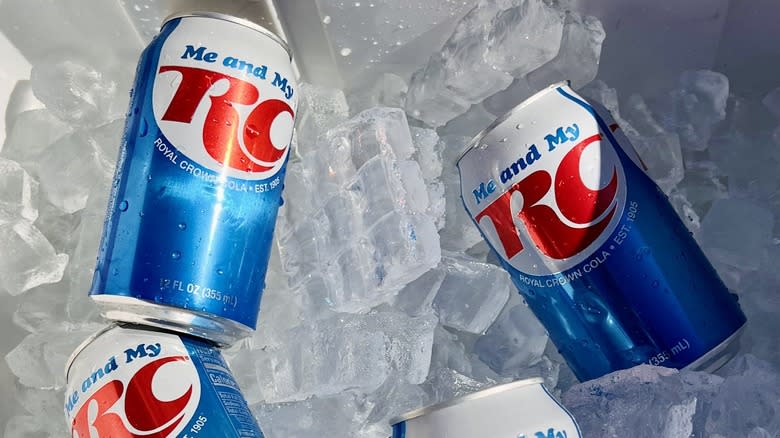
Georgia isn't just the home of Coca-Cola — it's also the birthplace of one of Coke's main competitors. The company that would eventually make RC Cola was founded in Columbus, Georgia by pharmacist and grocery store owner Claud Hatcher in 1905. Hatcher started making soda in the basement of his family's grocery store, initially bottling Royal Crown Ginger Ale. Within a couple of years, the company began producing industrial quantities of several varieties of soda, most notably Chero-Cola before producing a fruity drink called Nehi in 1924.
After being renamed as the Nehi Corporation, the company introduced Royal Crown — the ancestor of RC Cola as we know it today — in the 1930s. In 1951, the company was renamed yet again after its most popular beverage, which at the time was called Royal Crown Cola.
Royal Crown, shortened to RC, has been a pioneering force in the beverage industry — it introduced 16-ounce soda bottles in 1958, and produced the first mass-market sugar-free cola. Taste-wise, RC carves its own path in the cola wars, with an emphasis on citrus and cinnamon and a more muted vanilla flavor compared to other cola brands. When Tasting Table ranked popular colas, RC lost out to Coke but bested Pepsi.
Quadruple Coronary Bypass Burger
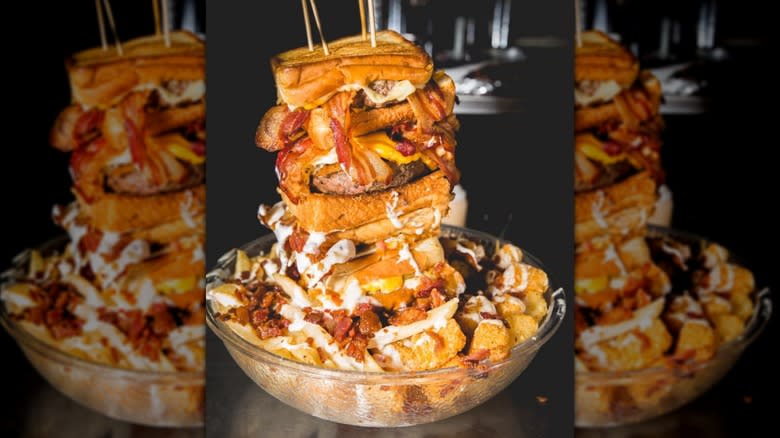
We've covered Georgia's traditional favorites with long histories, beloved fast-food places, and prized agricultural products, but there's one more genre of dish we need to discuss on this list: novelty stunt food. The Vortex is a burger joint with two locations in Atlanta. It serves a variety of creative burgers, sandwiches, and fried bar appetizers — but its most infamous (and over-the-top) menu item is the Quadruple Coronary Bypass burger.
This monstrosity consists of four patty melts that serve as the "buns" of the burger tower. Sandwiched between the patty melts are two additional half-pound sirloin patties, 27 pieces of bacon, nearly 30 slices of cheese, onions, relish, mayo, and four fried eggs, all topped with cheese sauce and bacon bits. When combined with its included side of a combined 20 ounces of fries and tots, this meal contains nearly 10,000 calories.
As you might expect, the Quadruple Coronary Bypass was originally designed as an eating challenge, but during the pandemic the restaurant had to suspend this offer. Back when the challenge was open to the public, if you ate the whole sandwich along with the fries, tots, and at least two 32-ounce fountain drinks, you earned the honor of your super-sized meal being comped, plus having your photo appear on the eatery's social media pages and getting a T-shirt for your efforts.
Static Media owns and operates Tasting Table and Mashed.
Read the original article on Tasting Table

 Yahoo Lifestyle
Yahoo Lifestyle 
